Displaying items by tag: Peter Malone's Movie Reviews
Banlieusards/ Street Flow
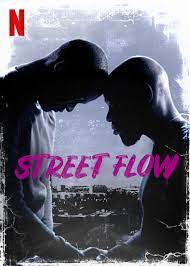
STREET FLOW/ BANLIEUSARDS
France, 2019, 96 minutes, Colour.
Kery James, Jammeh Diangana, Bakary Diombera, Chloe Jouannet, Matthieu Kassovita..
Directed by Kery James, Leila Sy.
Street Flow, with its French title the slaying for those who live in the suburbs of Paris, is a project from celebrated singer/actor, Kery James. He has written the screenplay, co-directed and appears as the oldest of three brothers. He has a strong screen presence.
This film is one of a number of films from the 1990s which focus on issues in the outer suburbs of Paris, the enclaves, regions separated by rivers and highways, the poverty of the inhabitants and, especially, racial issues and violence, especially with the presence of migrants from Africa.
A pioneer in this kind of film was the 1995, La Haine, which starred Matthieu Kassovitz – and memories of that film with his appearing in a cameo here as a boxing coach. Another striking example was that by Romain governess, the highly stylised Athena. Street Flow was so successful that in 2022, there was Street Flow 2.
The basic story is not unfamiliar and there was some criticism of the film because of its obvious characters, treatment. However, there is still some power in the story of a widow and her three sons, the oldest gone wild, a thug, in prison, emerging as a leader in drug dealing and violence, the second son the good son, starting to be a lawyer, and the third son, younger, at first opting for following his older brother, suspended from school, robberies…
The film gives attention to each of the three brothers in the context of the suburbs, complexities with the need for help from the oldest brother to warn the youngest against a life of violence. In the meantime, the middle brother, studying law, is preparing for a public debate for credit, working with his rival, the touch of romance, personal difficulties, the long sequence of the debate about the responsibility of the state for the suburbs, his mother and his brothers all attending the debate.
Because the problems in suburban Paris continue, the film has relevance – so much so that there was the sequel.
- The title, life in the streets, the suburbs of Paris, divisions, enclaves, race issues, gangsters, drug issues, poverty?
- The locations, the suburbs, homes, streets, school, college, debating halls? Drug deals, centres? The musical score?
- A story of three brothers, the bad, the good, the young man in the middle? Absent father? Caring mother? The moral dilemma for the teenager and his future, for the good brother and his professional future?
- The mother, racial background, husband, the children, said history, her care at home, the domestic sequences?
- The focus on the older brother, place in the family, absent father, alienation from his mother, the drugs, his leadership, henchman, relationships, violence? Time in prison? Personality?
- The middle brother, age, studies, decisions, support of his mother, concerned about his younger brother? Study, qualifications and ambitions? The rivalry in studies, preparing the debate, going out with the girl, the relationship? The theme of the debate, the responsibility of the state, the suburbs, poverty, law and order? The ups and downs of the relationship, some alienation?
- The youngest brother, age, experience, the models provided by his two brothers, the opting for trouble, his mother’s reaction, the support of the older brother, yet concern about him? Getting into trouble, crime, stealing? The older brother and his interventions?
- Killings, in the street, the rivalries, gangs?
- The middle brother, the symbolic encounters, on the bus, the thugs? And his being held up on suspicions by the police?
- The boxing gym, the coach and his support?
- The finale with the debate, rhetoric, political issues, the audience, his brothers been present?
- The finale for the youngest brother, and the change of relationship to the older brother?
- The tradition of French films since the 1990s to show racial and crime issues in the suburbs of Paris?
Sly
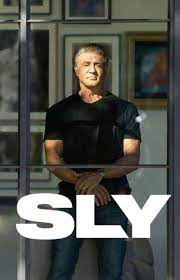
SLY
US, 2023, 95 minutes, Colour.
Sylvester Stallone, Frank Stallone, Quentin Tarantino, Henry Winkler, John hurt’s felt, Talia Shire, Arnold Schwarzenegger, Wesley Morris.
Directed by Thom Zimny.
This documentary on Sylvester Stallone and his career was made when the cinema icon was in his mid-70s, born 1946. Although only 95 minutes, it offers quite a comprehensive look at Stallone and his life, the various stages of his career.
What makes the difference is that the bulk of the documentary is Sylvester Stallone talking, his confiding in his interview in a variety of locations, where He grew up, studios, in cars… (And it would make an effective audiobook with the words and intonations of the star). There is quite a lot of commentary on many of Stallone’s films and many clips.
The principal commentator on the Stallone family is Sly’s younger brother, Frank. Significant people in his career include Henry Winkler with whom he appeared in The Lords of The Bush, his co-star in the Rocky films, Talia Shire, Arnold Schwarzenegger reminiscing about previous rivalry and getting over it. Critic Wesley Morris makes frequent comment. And, there is plenty of exuberant commentary by Quentin Tarantino.
Some commentators have said that there is not enough of Stallone’s private life, his first marriage, his second marriage, his children, and his son’s age who died in his 30s from illness – although, there are some sequences from Rocky V where the actor interact with his son. Stallone’s wife of 25 years plus, Jennifer Flavin, is seen with their children.
Stallone is very Frank about his growing up, revisiting the New York locations, the harshness of his upbringing, not being interested in school, the severity of his father, discipline and expectations, the absence of his mother – all supported by commentary from Frank Stallone. There are memories of his auditioning for Death of a salesman and the agent urging him to a career in theatre.
While Stallone is often considered to be monosyllabic mumble, thinking of his character, Rocky, in fact he is very articulate in commentary, in press conferences, quite a range of vocabulary during this film. Plus the fact that he was a writer. It is great emphasis in the film on his writing, visuals of his written manuscript, crossings out, revisions.
But, as expected, a lot of attention is given to the emergence of rocky, his writing the screenplay, small budget, collaboration with the director, the choosing of the cast, the parallels with his own life, the decision that Rocky should be a boxer, initial indifference cinema patrons reactions, but the surprise of audible cheers during the initial release in New York. A claim, Oscars.
Attention is given to the immediate aftermath, Stallone’s attempt to be serious in FIST, directing Paradise Alley, the attention given to the sequels and some critical expectations, the very personal nature of Rocky V. While some attention is given to the sixth film, Rocky Balboa, almost 20 years later, there is no inclusion of the Creed franchise.
Which leads, of course, to Rambo, the effect of the Rambo films in the 1980s (which is where Schwarzenegger’s commentary comes in about his action films of the 80s), the personal investment Stallone made, and his dispute with the filmmakers, his philosophy of cinema that audiences don’t watch want unhappy ending is – and his final statement that he believes in a cinema of hope.
There are the various ups and downs of the 90s, his attempted comedy, not particularly successful, his continued career and the launching of The Expendables.
The audience feels that it gets to know Stallone quite well during the 95 minutes, his talking to his audience, confiding in them, being very Frank, ups and downs. Whatever the future as he nears 80, he has had a career for half a century.
Killer, The
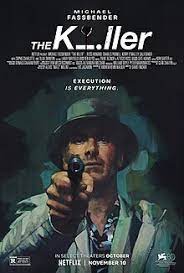
THE KILLER
US, 2023, 118 minutes, Colour.
Michael Fassbender, Tilda Swinton, Charles Parnell, Arliss Howard, Kerry O'Malley, Sophie Charlotte, Sala Baker.
Directed by David Fincher.
A David Fincher film, an alert to his many fans for almost 30 years. We remember Seven, Fight Club, Social Contract – and we anticipate some tough content and style. And that is what we get.
The screenplay is based on a graphic novel, with six chapters, focusing on the work of the central character, targets, experts, lawyers… The title is very plain, straightforward. Hitman would have been better but this has been taken already in a number of films. And The Killer has no personal name – but a plethora of passports with a range of false identities, enabling him to move from country to country with ease, tracking his targets, confronting his controller, seeking out personal vengeance.
But, for the audience, The Killer is very personal. Michael Fassbender is an actor whom the camera loves, always interesting, always fascinating, and here the audience goes along with him, sharing his experiences (though always with a sense of dread and some touches of feeling guilty complicity), but, particularly, The Killer with voice-over, confiding in the audience, explaining what he is doing, why he is doing it. And he repeats his mantra: " Stick to the plan. Anticipate, don't improvise. Trust no one. Yield no advantage. Forbid empathy."
The film opens in Paris, The Killer in a hotel room, preparing his weapon, surveillance of the apartment where his target will appear. And, despite a meticulous record, the assassination attempt fails. He is sighted, pursued, but with his extraordinary chameleon-like ability to blend in the crowd, change clothes for disguise, draw on his many passports with names from earlier television programs, is able to get back to his retreat in the Dominican Republic, only to find an attempt and vengeance on him, but brutalising his companion. He is merciless in pursuit, tracking down local taxi drivers and his companions brother to get further information, and shooting potential witnesses without qualm.
From then on, The Killer is on his own vengeance track, taking him to the corrupt lawyer who turned him from legal studies into a hitman (Charles Parnell), mercilessly getting information from his fearful assistant (Kerry O’Malley), then to Florida for the first step in vengeance on the attackers in Santo Domingo, trips to New York, to Chicago, and the completing of his merciless mission. And, at the end, there are excellent cameos from Arliss Howard and, particularly, from Tilda Swinton who is given significantly interesting dialogue reflecting on executions, targets, motivations, money, greed.
In the background are questions of values, meaning of life, The Killer living in the hell of his own, creating hells, only momentary signs of possible redemption in his relationship with his companion. Which means that we have experienced a thriller, a screenplay with wry and ironic dialogue, a story of emotionless and ruthless violence.
- The title? Based on a graphic novel? The influence of French gangster films?
- The locations, the city of Paris, the apartments, airports, the Dominican Republic, the countryside, the mansion, the taxi service headquarters, New Orleans, the lawyer’s office, Florida, the scenery and the assessment, New York, the restaurant and Riverside, Chicago and the business office? The dividing of the structure into chapters and titles?
- The anonymity of the killer, his many passports and identities?
- The voice-over, the Killer and his explaining his philosophy, a continued mantra, reciting it in action? The temptations to improvise, to stay with the plan, no empathy? Consequences of empathy?
- Michael Fassbender as the Killer, performance, screen presence, attractive to the audience, yet alienating them? His regime, exercise, fitness, alert, contact with his minder in New Orleans? Surveillance, patients, seeing the target? His weapons, sites, aiming? The arrival of the dominatrix, the episode, his failure? The effect, being seen, the escape, disguises, the airport?
- The situation in the Dominican Republic, the mansion, his companion, her being brutalised, hospital, her giving the information about the assailants? The interrogation of her brother, the taxi driver and his being shot?
- The lawyer, in New Orleans, law professor, tempting the Killer away from his legal studies? Control? His assistant, her fears? The confrontation, shooting the lawyer? Taking the assistant, the files, the information, at home, killing her?
- The information, going to Florida, stalking the assailant, the brutal fight, killing him?
- Going to New York, the description of the partner, following her, the restaurant, the discussions with her, the waiter on the menu, her philosophising about her life, the inevitability of her death, issues of money and greed? The interactions between the two, his suddenly killing her?
- The visit to Chicago, the identity of the employer, in his office, his ruthlessness, money, confrontation with the killer?
- The end, his return to the Dominican Republic, his companion?
- Morality, amoral attitudes, wilfully, creating hells for people, the killer creating a hell for himself? Any possibility for redemption?
Beyond the Wasteland: Mad Max
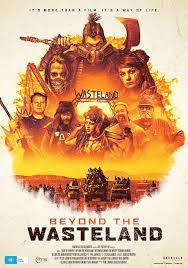
BEYOND THE WASTELAND
Australia, 2022, 92 minutes, Colour.
Bertrand Cadert.
Directed by Eddie Berouthy.
The Wasteland of the title is Mad Max territory.
This is a documentary about fandom, international fandom, not only at the time of the initial release of the film but a celebration 40 years later.
The film focuses particularly on the first Mad Max film, 1979, interviews with George Miller himself, with various actors from the original including Steve Bisley, Roger Ward, Joanne Samuel, and various people who portrayed the idiosyncratic supporting characters. There is commentary by Luke Buckmaster who wrote a book about the films. There is commentary by Alan Finney, publicist at the time.
And there are sequences from the original film, reference to the second film, The Road Warrior, a nod in the direction of the third film only, and reference to the later films focusing on Furiosa.
However, the main thrust of the documentary is a pilgrimage! The audience is introduced to Frenchman, Bertrand Cadert, who came to Australia in the 70s, found himself with a role in the original film, kept in touch, fostered the memory of the film, collected all kinds of souvenirs. Suffering from leukaemia, he decides, the doctor encouraging him, to go on this pilgrimage. With the aid of a screen map, the audience sees him drive from Queensland through western and central New South Wales to Victoria, to the town of Clunes, where many of the fans, the actors, technicians, have come to celebrate the 40th anniversary of Mad Max. Those who gather our young and old, a re-creation of some of the stunts, especially a car crashing through a trailer, and enthusiasts gathering up relics to keep.
The busy camera, roaming the streets, capturing people, interviews, stunts, reminiscences… And, not forgetting the elaborate costumes and their re-creation, fans proudly wearing them.
On the way back, Bertrand visits Silverton, used for Mad Max 2. We are introduced to the owners of the pub, reminiscing about the time of the filmmaking, of other crews coming to the town, of the range of pilgrimages.
And, throughout the film, there are lengthy interviews with international fans, from France, from the US, from Italy, from Japan, seeing them in their home countries, rules and conventions, but also seeing them coming to Australia, some of them amazed at the vastness, but relishing their Mad Max experiences.
Who would have thought? Back in 1979?
Killers of the Flower Moon
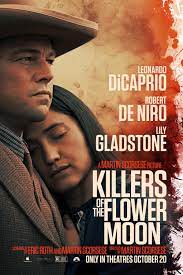
KILLERS OF THE FLOWER MOON
US, 2023, 206 minutes, Colour.
Leonardo DiCaprio, Robert De Niro, Lily Gladstone, Jesse Plemons, Tantoo Cardinal, John Lithgow, Brendan Fraser, Martin Scorsese, Cara Jade Myers, Janae Collins, Jillian Dion, Jason Isbell, Scott Shepherd, Tatanka Means.
Directed by Martin Scorsese.
By 1918, when this film opens, Native Americans were something of a lost minority in their own land, in reservations, or wandering from place to place in the Oklahoma Badlands, as is with the Osage Nation here. In silent film style, the situation is dramatised, poverty and on the move, the sudden gushers of oil on Osage Land, unexpected wealth and affluent lifestyle, befriended by Whites, patronised by Whites, and the targets for intermarriage and inheriting land and oil rights. It is not yet 40 years since Cochise and Custer’s Last Stand at Little Big Horn.
There is also a preface to the film where Osage Elders gather, talk about their traditions, and regrets that the next generation is being taught by white teachers, their learning other ways and forgetting their own.
Into this world comes Ernest (Leonardo DiCaprio), returning from being a cook on the French battlefields. Not the smartest, he is welcomed by his highly reputed uncle, King (Robert De Niro), and his brother Byron (Scott Shepherd). King seems to be benign personified, promoting the welfare of everyone in the town of Fairfax, whatever their origins. Ernest runs a taxi, and is eager to drive Mollie (a dignified and quietly passionate Lily Gladstone) to her mother’s house. She has several sisters, who are involved with white men. And then the visual information that many Osage die. King encourages Ernest’s interest in Mollie for marriage, children and inheritance reasons and, while Ernest continually smiles and gloats that he loves money, he does fall in love with Mollie.
Martin Scorsese has made films for over 50 years, so many of them about American crime, especially gangsters. And this time, he takes up the cause of the Native Americans, and their being victimised by criminal greed and violence.
And this is a very long film, 3 ½ hours. And, to make a comparison with the film, Oppenheimer, it presents itself in three parts. The first part introduces the characters and issues, immerses the audience in the life of the town, part frontier, part stable, and the interaction between white and Native American. Once this is established, the second part focuses on the characters, the events, the violence, the exploitation, King, continually smiling, yet a Machiavellian influence, Bible quoting, especially on Ernest for whom greed and loyalty to King affect his love for his wife, who is suffering from diabetes, the beginnings of the availability of insulin. The third part, like the third part of Oppenheimer, might seem something of anti-climax to those very much involved in the action. The third part is the legal part, the arrival of FBI agents, investigations, prison, court sequences. But a necessary third part to evaluate the rights and wrongs, mainly wrongs, of what we have seen.
As expected, the performances are excellent – and, in the third part, some welcome cameos from Jesse Plemons, John Lithgow, Brendan Fraser and, in a tantalising finale to the whole film, the audience taken to a 1940s radio studio and participating in the dramatising of this story, led by the show’s producer, Scorsese himself.
The film is an important piece of Americana, a conscience-jolting exploration of the defeat and exploitation of the Native Americans.
- The title, and the American killers, the season of beauty, the fields and the flower moon vistas?
- American history, first Nations Americans, the opening, the silent film style, the situation of the Osage Nation, migrations, minority, the discovery of oil, the vista of the gushers, the ownership of the oil, the scenes of exploitative wealth, cars, clothes, jewellery, and the succession of murders, bodies lying in state?
- The scenes with the Osage nation, assessing the present, the next-generation being taught by Whites, the white ways, the changes, the 1920s and this coming into fulfilment? The various dignitaries, their leadership? Henry, his role in leadership, his drinking, ultimate collapse, his death?
- The structure of the film, the first part the introduction, the second part, the murders and exploitation, the third part justice and legal issues?
- The locations, Fairfax, the railway and the trains, the streets, the bars, homes, mansions? The interiors? The prison, the courts? And the finale on the radio station? The musical score?
- Ernest returning home, the American situation, 1918, serving over there, the reputation of the troops, Ernest as a cook? Not the brightest? Coming home to his uncle, to Byron? Agreeable, naive? Believing in his uncle? Promotion? Driving the taxi, the encounter with Mollie, his uncle’s plan, marriage and murder, inheritance? Interaction between Mollie and Ernest, making her laugh, her inviting him in, the meals, the mother, the sisters?
- The character of William King Hale, Robert De Niro’s performance, quietly sinister, the smile, the smooth talk, quoting the Bible, relationship with the Osage, bringing the benefits to the town, prosperity, but his overall plan? At home, meeting people, always smiling? Machiavellian? Scheming, plotting, advising? His role in the deaths of the Indian women, the inheritance of the oil wealth?
- The moral climate of Fairfax, attitudes towards the First Nations, the oil, wealth, Ernest and his love for money, almost equal to his wife? The men in the bar, Byron and his contacts, the murders, colours, planned, the set-ups, Anna, her wild life, Byron, her pregnancy, the visuals of her drunkenness, her murder? The autopsy, cutting up the body, the search for the bullet? Anna and her relationship with his mother, her mother’s favourite?
- Smith, his relationship with his wife, her illness, the picnic scenes of the sisters together, her death? His reaction, hiring the detective? Relationship with Reta, marrying, her being a comfort to him? His becoming the target?
- Ernest, the revelation of his motivations, connections, setting up the killings, the loan of the car, the insurance scheme? The killers, their backgrounds, prison? Their characters, callous? Byron and his role, with the women, with King, with Ernest?
- Mollie, at home, with her mother, her mother favouring Anna? Life-and-death, traditions, the vision of the owl? Her death?
- Mollie, the diabetes, her health, in love with Ernest, the marriage, the ceremonies and joy, her pregnancy, over the years, the children? The doctors, the insulin? The brothers and their medical expertise, exploitation? Ernest and the injections, a means for Mollie’s death and the inheritance? Mollie and the vision of the old?
- The murder of Henry, the killer, his change of heart, meant to look like suicide? The hiring of detectives, their being brutalised, the visit to Washington, the representation of the Osage, Mollie and her talking with President Coolidge?
- The FBI investigator, White, his arrival, interrogations, Ernest putting him off because of Mollie’s health, King and his smooth talk? The further investigations, the variety of agents arriving, uncovering the truth?
- Ernest, his being arrested, his complicity in the planning of the murders, the bombing of the house and its destruction? The old man who witnessed Anna’s death and his giving testimony? The arrest of King? King, the signed deal with Ernest, his being observed?
- Ernest and the interrogation, keeping him standing, holding his relationship with Mollie over him, his children? The news of the youngest child to death, the hooping cough, the Coffin?
- King, arrested, agreeable, in prison, the pressure on Ernest? His threats to Ernest in prison, holding Mollie’s health over him? Ernest being freed, talking with Mollie, the funeral, promising to tell the truth, his admissions – but the question of his injections for Mollie? Her being in court, her walking away from him – and the final information about the divorce?
- Ernest, his change of heart, his testimony, condemning King? The callous murderer and his offhand testimony in court, telling the truth?
- The lawyers, the defence, speeches in court, dominating Ernest? The prosecutor and his rhetoric?
- The very American ending, the radio program, the announcers, the actors and two voices, the white man and the Osage voice, the special effects and sounds? The information about the case, Ernest, imprisonment, release, with Byron, the divorce, Mollie and her new life, her death? King, jail, release, his death?
- The final visuals of the Osage Nation, the rising drone shot, the pageantry?
Darkness within La Luz del Mundo, The

THE DARKNESS WITHIN LA LUZ DEL MUNDO
Mexico, 2023, 113 minutes, Colour.
Directed by Carlos Perez Osorio.
A powerful documentary from Mexico – with a story which will be well-known in Mexico and in Central and Latin America but less well-known in the English-speaking world although its culminating trials took place in Los Angeles.
La Luz del Mundo is an evangelical church which was founded in Mexico in 1926 and soon developed, spread, became powerful and wealthy by the end of the 20th century, and was established in many countries throughout the world, even with a branch in Sydney.
Audiences familiar with the development of evangelical churches in the 20th century in the south of the United States, will be interested in the similarities with Mexico. Audiences wary of the leadership of this kind of church, the possibilities for cult leadership and indoctrination, the possibilities for exploitation by the leaders, will find this film even more interesting. Audiences with a variety of attitudes towards the tele-evangelists, their methods, their preaching, their money collection, their affluent lifestyles, will also be eager to watch this story.
In its almost 100 years history, the church has had only three leaders, Aarón (Eusebio) Joaquín González, Samuel Joaquín Flores, and Naasón Joaquín García. There are some flashbacks and photo visual material on the founder, but the first part of the film focuses on his son, Samuel, and his leadership of the church and its extraordinary growth, visuals of the disciples, their intense faith, the enthusiasm, their belief in the leader as “the Apostle of Jesus Christ”. Samuel died in the 1990s and the leadership was assumed, a process of religious discernment decided that he was also The Apostle, by Naason, who, to all appearances, did not look as if fulfhe could fulfil the requirements of this kind of leadership.
So, this documentary takes its place as a portrayal of a religious group, Christian aspects, clashes with the Catholic Church and leaders in Mexico, a building program, a communal program, and thousands of avid and devoted disciples, old and young, men and women.
However, it is also a story of cult leaders and sexual exploitation. For audiences who are connected in any way to organisations whose leaders and members have been arrested, tried and condemned for sexual abuse, especially of minors, this is an important film because it is looking, from their point of view, very objectively at abuses, at offenders, at victims, at survivors, listening to their testimony.
Eventually, a number of women were prepared to speak openly about their sexual experiences, especially young women, young teenagers, who were chosen by the leaders, especially Samuel and then his son, with the aid of female members who were the equivalents of pimps, grooming these young women, leading them into sexual behaviour, the loss of their virginity, the bewilderment of their experiences.
As always, it is very moving to listen to these testimonies and the saddest of memories, of abusive and destructive experiences.
There is a great deal of information and visuals about Naason, he is arrested, in the United States, on trial in Los Angeles. This documentary covers the various trials, his pleas, denials, compromises, imprisonment, deals, right up to decisions by the end of 2022, the judge listening, sentencing, but bound by limitations for which he apologises, especially to survivors, making the documentary very up-to-date at the time of its release to Netflix.
Clearly, this kind of story, this factual documentary, often stark and direct, can be very disturbing viewing. With this caution, it is a documentary that should be seen widely, contributing a Latin American perspective, unfamiliar to many audiences, to the exposure of organisational sexual abuse, especially in the latter part of the 20th century and into the 21st-century.
Rotting in the Sun

ROTTING IN THE SUN
US/Mexico, 2023, 113 minutes, Colour.
Jordan Firstman, Catalina Saavedra, Sebastian Silva, Matteo Riestra, Juan Silva.
Directed by Sebastian Silva.
This is a small-budget, independent film, introduced at the Sundance Film Festival. It is not a mainstream film, distributed in the arthouse circuit.
Sebastian Silver is a prominent musician, artist, film writer and director, from Chile but also working internationally. Prominent amongst his feature films are The Maid, Magic Magic, Crystal Fairy and the Magical Cactus.
This is a gay film, a gay culture film, Silva himself openly gay. With his long-time writing partner, Pedro Peirano, he has created a character, with his name, but a variation on his persona. He is joined in the film by comic writer, producer and comedian, Jordan Firstman, also doing a variation on his persona and career.
The setting is Mexico City, the screenplay making some comments on how Americanised Mexico has become, the presence of visitors from the US, poverty, wealth, holiday resorts… And, with the depressed Silva urged to go to a resort, the film goes to a gay nude beach, frank and direct nudity and sexual activity. At the resort, Silva rescues Firstman caught in a rip. Firstman gets the idea of using Silva to work on a television series, personal and encounters with people.
This strand of the film continues, pressure from Firstman, reluctance from Silva, but contact with HBO who like the idea and meetings are set up.
Then comes the main part of the film, Silva with the maid (played by Catalina Saavedra, his star in The Maid), are working in a house being repaired by a friend who continually eggs on Silva. Carrying a sofa from upstairs, there is an accident, Silva falling to his death, the maid anxious, contacting her brother, hiding the body, planning to remove it, and lying about the situation, especially with Firstman interrogating her, his phone doing translations, the situation becoming more and more dire.
Firstman then calls Silva’s brother to visit (played by Silva’s actual brother).
And, interspersed throughout this narrative there are various characters shown in the house and elsewhere, gay men involved in sexual activity.
The film won awards from its target audience – many audiences may be put off by its explicitness. However, in terms of drama and comedy, the story of Silva’s death and his body being moved about seems something of a very laboured variation on the Weekend at Bernie’s comedy farce.
Mad about the Boy: the Noel Coward Story
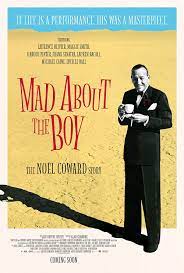
MAD ABOUT THE BOY: THE NOEL COWARD STORY
UK, 2023, 92 minutes, Colour.
Directed by Barnaby Thompson.
In the 1930s, Noel Coward was a celebrity in England and in the United States, a personality in the media, an actor, a significant playwright, a composer of songs with arresting and delighting lyrics. He continued this persona in later decades, contributing to the British World War II effort with the film, In Which We Serve, continuing to write plays and to perform, writing significant screenplays like Brief Encounter, appearing to advantage as a guest star in films like the 1969, the Italian Job, a prison variation of his sardonic persona.
This documentary, narrated by Alan Cumming, with quotations from Coward himself voiced by Rupert Everett, takes the audience through Coward’s life, comparatively poor circumstances, bond with his mother and family, little formal schooling, auditions and acting, success during his teens, self-educated. The film also illustrates how he changed his persona as the years went on, adopting the sophisticated air, the arched tones and intonations of voice, his comic timing and wry humour. There are interviews with David Frost and other television interviewers, scattered throughout the film, illuminating the various aspects explored by the documentary. And, as the title suggests, there are many excerpts from his songs.
A great deal of attention is paid to Coward’s dramatic career in the theatre, in the UK, sailing to the US and overwhelmed by Broadway, his writing of The Vortex, its success, its condemnation by moralists, the continued performances and Coward’s own presence on stage. Which leads to a significant focus on his key play, Private Lives, excerpts, vocal excerpts, his work with actress Gertrude Lawrence.
Noel Coward certainly belongs to past eras, audiences familiar with those decades enjoying this encounter with Coward. He may not be familiar at all with younger generations. And, his very British upper-class accent and attitudes could be offputting.
However, this film with its many quotes from his works, while not a deep exploration of his personality, his homosexuality (presented in a very matter-of-fact way here), or his influence on theatre, cinema, music, it is an opportunity to have a taste of his achievements, to hear him speak (and enjoy his sometimes wry comments, self-deprecating). He had, as he said, “a talent to amuse”.
Dive, The
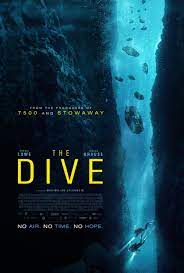
THE DIVE
Germany, 2023, 91 minutes, Colour.
Louisa Krause, Sophie Lowe.
Directed by Maximilian Erlenwein.
It is probably a good sign of the times to have women protagonists in action adventures that used to be the prerogative of male protagonists. In recent years, there have been underwater adventures, like this one, featuring women, or mountain climbing challenges, women trapped on ledges. The Dive, filmed in Malta, with some spectacular cliff scenery, and underwater Mediterranean photography (as well as in studio tanks), has two sisters driving to a remote location for scuba diving.
In fact, the premise of the story is quite simple. And it could happen. There is always this kind of risk. The two sisters are exploring, there is an underwater shower of rocks, one of the sisters being trapped, her leg caught by a substantial force. And, for the sisters, and for the audience, the questions of the amount of air available, how to lift the rock and free the leg, is the issue of whether there is anyone around (in fact, there is a church with a large cross, and some Catholic imagery, but no one there). What about the timing, the energy of the sister who has to perform all the steps for the rescue, the pressure on her, the worry. And, the fate of the woman trapped below the ocean surface.
This is quite an international film. It is a German production, the director himself German. One of the sisters is played by Louisa Krause, an American actress, the other by Sophie Lowe, from Australia. And the dialogue is in English. It is based on a 2020 Norwegian film, Breaking Surface.
The impact of the film will depend on the audience’s attitudes toward scuba diving, enthusiasts will be interested, others might find it too remote from their own experiences. And there is something frighteningly claustrophobic about being trapped underwater. And there is the continual challenge – what would we do in similar situations, what is the effect of the physical pressure, the psychological pressure, and how much inventiveness and creativity would we have for the rescue?
For the first 12 minutes, the main intention is the relationship between the two sisters, memories of their father, playing together, diving together, some falling out – and a few flashbacks throughout the film, personalising the underwater crisis.
So, enjoyment value will depend on the impact the sisters make, audience response to the dangerous situation, and the challenge for a rescue (which, does not quite turn out as we might have been expecting!).
- The title, straightforward, the plot and relationship between the two sisters, tensions, the scuba diving, the remote place, the accident, the rescue?
- The Mediterranean settings, remote, the vast cliffs, the beaches, the water, the underwater photography, fish, the crags and cliffs, canyons, the rock shower? The church, the interiors, the iconography? The remote boat? The flashbacks? The musical score?
- The two sisters, the tensions in the car, the relationship, memories of their father, the flashbacks, swimming, companionship, rivalry? The bonding scuba diving?
- The remoteness, no one around, later seeing the church, the cross, the interiors, the iconography, the tools? The boat on the horizon? Writing the note for the rescue?
- The Joy of the swimming, the rock shower, the sister trapped, taking control, the issue of the oxygen, the tanks, the timing? Her staying underwater, the pressure? Her memories?
- The sister and her panic, the instructions for the oxygen of the tanks, going to the surface, the car locked, breaking the window, the tanks, going to the church, desperate, the tools, writing the note? Seeing the boat in the distance? The car boot, locked, pushing the car, the crash? The Pole?
- Going to the rescue, trying to lift the rock, the Pole breaking? The issue of the oxygen? Ultimately getting the leg free? The rescuer staying underwater, in the pool, unconscious, the other sister going to the surface, getting the oxygen, returning? Resuscitating her sister?
- The Joy of scuba diving, adventure? The personal story? The drama of the rescue, each sister rescuing the other?
Damage/ Australia
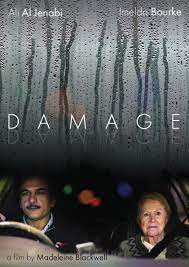
DAMAGE
Australia, 2022, 84 minutes, Colour.
Ali Al Jenabi, Imelda Bourke.
Directed by Madeleine Blackwell.
This is a very personal film written and directed by Madeleine Blackwell, an Adelaide-based story, but very much an Australian story.
One night, an Iraqi refugee, without a visa, takes his turn driving a taxi around Adelaide, using the identity card of a fellow driver. We see him prepare, go to his car, begin to look for passengers. The driver is played by Ali Al Jenabi, his only film.
Suddenly, he is accosted by an elderly lady, appearing out of nowhere, vague, lost, getting in the taxi, but not knowing really where she wants to go, rummaging in her purse, not having an address. She is played by Imelda Bourke, a noted singer from the past, this her only film. And, it is striking to discover that she is the director’s mother.
The tagline for advertising the film states that he wants to forget but that she can’t remember.
The driver has flashbacks to various aspects of life in Iraq, bombings, sports events, personal experiences. It colours his perspective, his defensiveness, touches of aggression, especially when the old lady challenges him with asking why he has come to “my country”. She has a lot of old prejudices against migrants, against Muslims.
There is a scene where the driver drops her at a Catholic church, comments about faith and different perspectives on God/Allah.
There is a striking sequence when the driver has to fill up his taxi with petrol but has been told by his phone boss that he needs to have the taxi cleaned. The driver becomes very anxious, some harsh memories of the past, desperate in fear of being overwhelmed by water, asking the old lady to drive, she refusing, saying she has forgotten how, going into the car wash, his being overwhelmed, the old lady left stranded, but eventually driving it out of the car wash. They then sit and talk.
So, within the brief confines of a taxi ride, destination uncertain, two unlikely characters meet, confront, share, come to some understanding. The driver does look in the lady’s bag, does get an address, wants to drive her to her daughter’s place, finding a destination, the old lady rescues her dog (initially unwelcome in the taxi), leaving the audience to wonder where this will lead, the driver being able to settle in Australia, the old lady able to find relatives and home.
The film works very well on this level of the interaction between two strangers. And, it makes audiences realise that there is a great deal of prejudice ingrained in Australian society that needs not only to be challenged, but to be experienced humanely, by authentic human contact.
- The title? Damaged people, damage continuing, healing and mending?
- The Adelaide setting, city sequences, the suburbs, the roads, service station, the Catholic Church, homes? The city by night? The musical score?
- A two hander, a taxi ride, the two actors and their only films? The director working with her mother?
- The driver, Iraqi background, no visa, driving the taxi, shared identity, preparing for the ride, the passenger, memories of Iraq, destruction, sports, oppression of water?
- The old lady, her age, suddenly at the window, getting in, vague, her purse, no address, loss of memory, minimal back story, her daughter, in care or not?
- The issue of refugees, Muslims, the prejudice of the old lady, the later Catholic Church visit, discussions about Allah and God?
- The service station, the issue of the car wash, the driver and his fears, going into the wash, flashbacks, getting out, the old lady saying she had forgotten how to drive, the driving out the car?
- Sitting on the bench, the talking, aspects of their stories? His taking her to the church, her getting back in?
- Her purse, and address, the drive to the glass building, the dog, not welcome the taxi, the coming back to the taxi?
- The film in the taxi, confined, yet audiences appreciating both characters, the interactions?
- The effect of the drive and the encounter on the driver? Some softening of the old lady, her attitudes? A future?